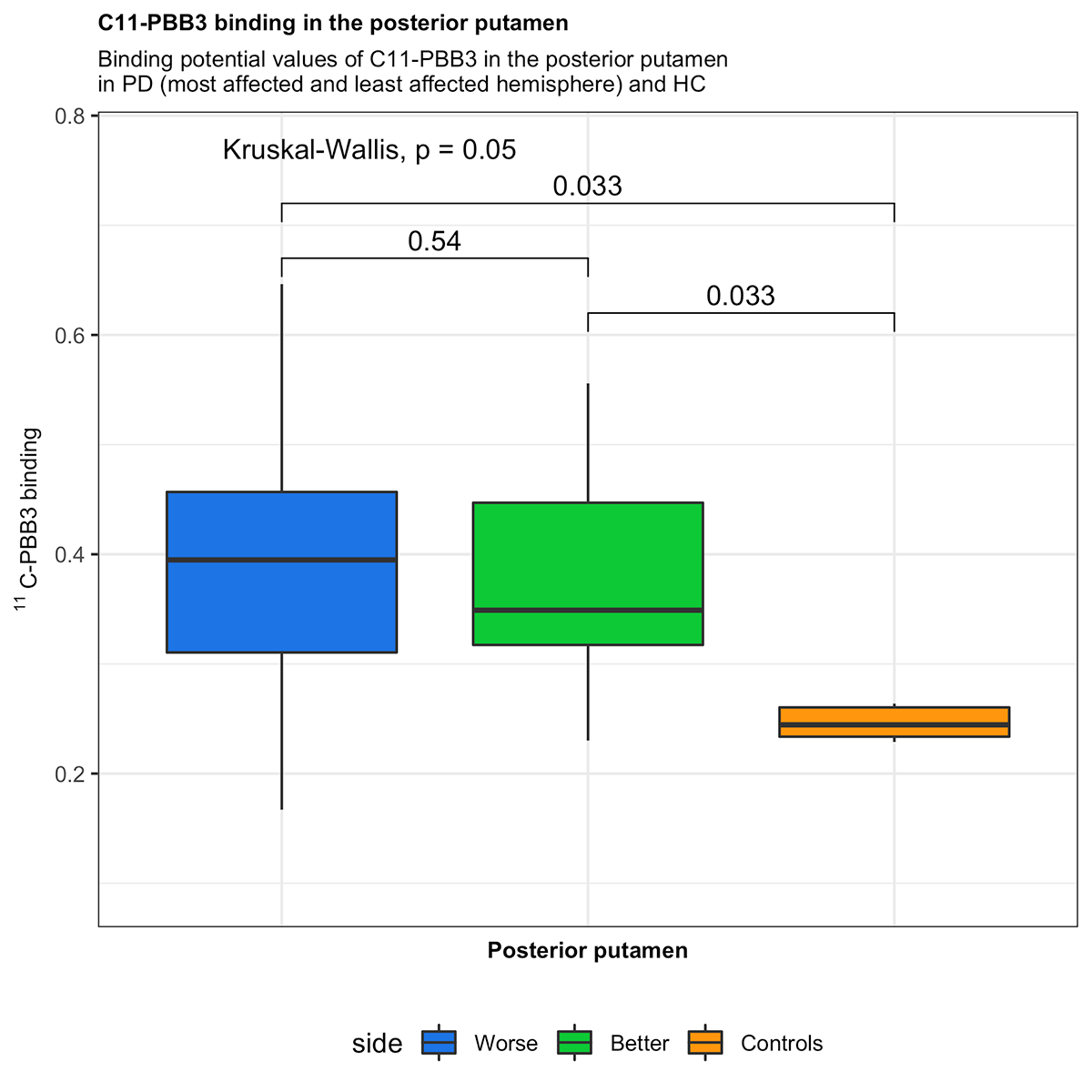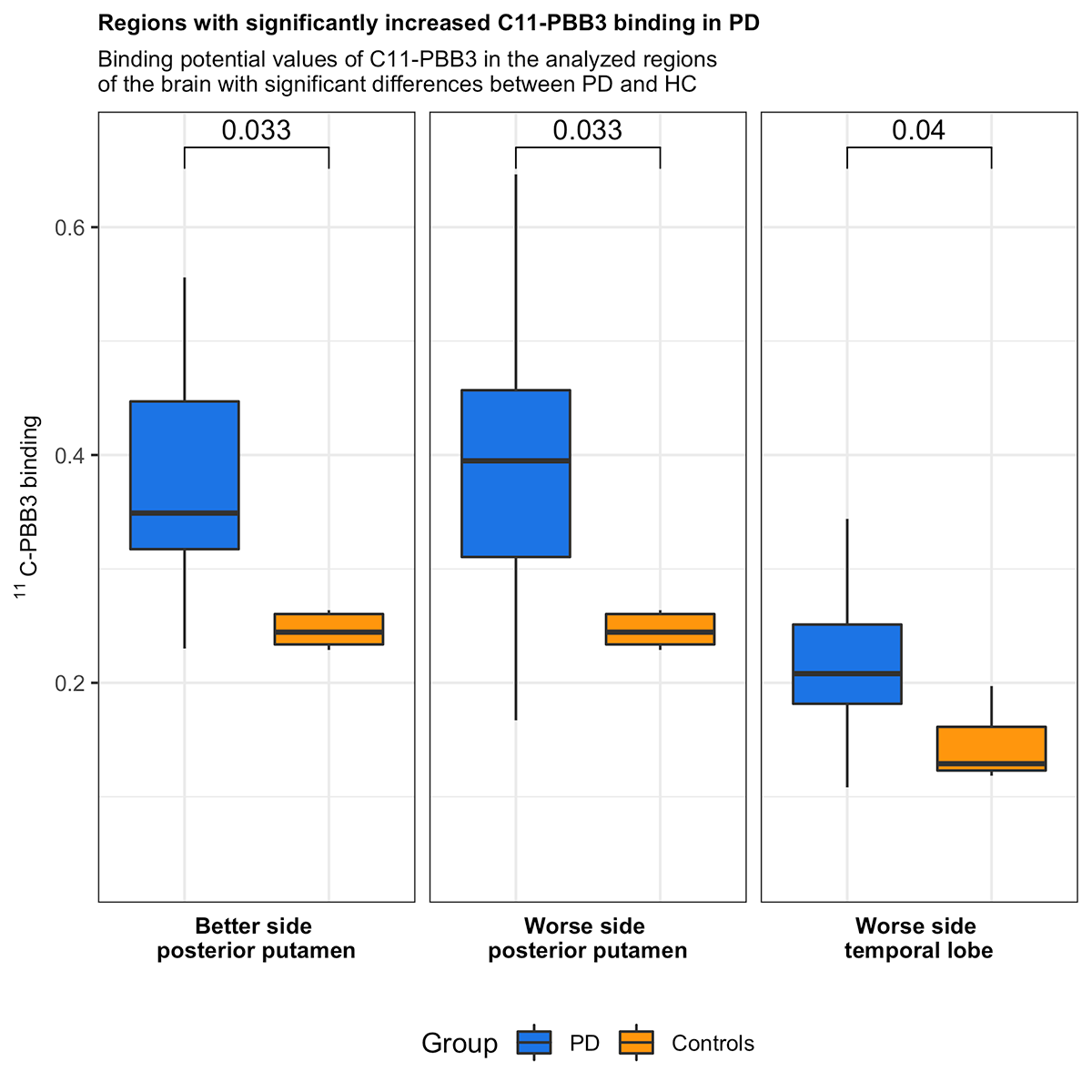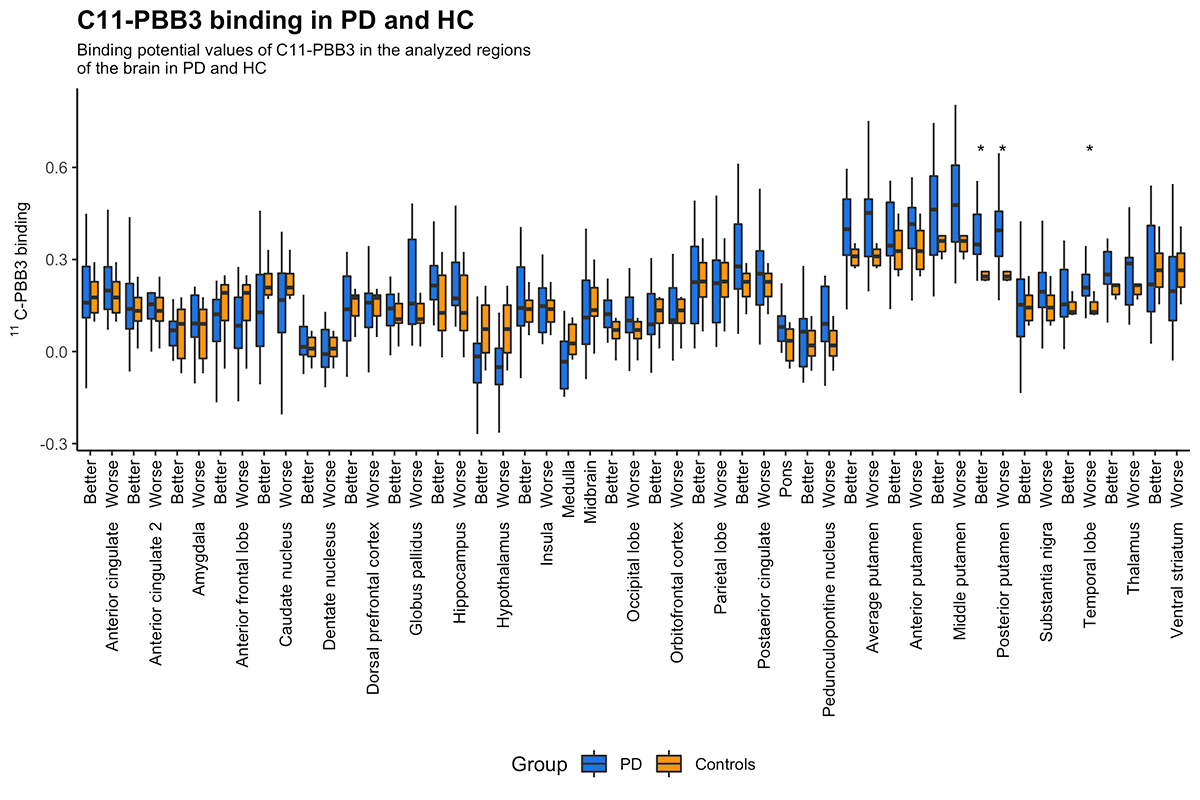Session Information
Date: Wednesday, September 25, 2019
Session Title: Neuroimaging
Session Time: 1:15pm-2:45pm
Location: Les Muses Terrace, Level 3
Objective: To use 11C-PBB3 PET binding to monitor alpha-synuclein (a-syn) pathology in PD subjects in vivo.
Background: In previous work we have shown binding of the tau tracer 11C-PBB3 in pre-symptomatic SNCA-multiplication carriers and an MSA patient [1], consistent with the known topography of a-syn pathology and with post-mortem studies in MSA [2]. We hypothesized that 11C-PBB3 could label a-syn pathology in vivo in idiopathic PD.
Method: We studied 11C-PBB3 binding in non-demented PD subjects and age-matched healthy controls (HC). All subjects underwent clinical evaluation, including MDS-UPDRS-III and cognitive testing (MoCA , DRS-2).
Results: We present preliminary results from 14 PD subjects and 7 HC, mean age 68.9 and 67.9 years, respectively. Disease duration was 7.9[IQR=6.6-11.2] years. We analyzed binding potentials, using Logan analysis with cerebellar white matter as reference region. Average binding was higher in PD in 63% of the studied brain regions (fig.1); this increase was statistically significant in 3 regions: bilateral posterior putamen and temporal cortex of the worse side (fig.2). Also, in the posterior putamen we observed a trend to higher binding in the worse vs better side in PD (fig.3). The nigral binding was slightly increased, but this was not statistically significant compared to HC.
Conclusion: The debate on the origin and the progression of PD in the brain is still open, and little is known about the role of a-syn [3]. The involvement of this protein as a pathogenic agent and its preferential location in the neuronal soma (i.e. Lewy bodies), with a bottom-up progression, represent the prevailing hypothesis, but other possibilities should be considered [3–5]. Our data show increased binding of 11C-PBB3 in bilateral posterior putamen in non-demented PD subjects, which could reflect a relatively higher a-syn load at this level, supporting the hypothesis that striatal nerve terminals are the primary target in PD [5–7]. We are however unable to exclude the presence of co-aggregated tau or off-target binding to other protein aggregates that may co-localize with Lewy pathology. Further studies with more selective tracers are needed to confirm these results and to assess the relation between disease progression and the topography and degree of binding.
References: 1 Perez-Soriano A, Arena JE, Dinelle K, et al. PBB3 imaging in Parkinsonian disorders: Evidence for binding to tau and other proteins. Mov Disord 2017;32:1016–24. doi:10.1002/mds.27029 2 Koga S, Ono M, Sahara N, et al. Fluorescence and autoradiographic evaluation of tau PET ligand PBB3 to α-synuclein pathology. Mov Disord 2017;32:884–92. doi:10.1002/mds.27013 3 Espay AJ, Vizcarra JA, Marsili L, et al. Revisiting protein aggregation as pathogenic in sporadic Parkinson and Alzheimer diseases. Neurology 2019;92:329–37. doi:10.1212/WNL.0000000000006926 4 Foffani G, Obeso JA. A Cortical Pathogenic Theory of Parkinson’s Disease. Neuron 2018;99:1116–28. doi:10.1016/j.neuron.2018.07.028 5 Burke RE, O’Malley K. Axon degeneration in Parkinson’s disease. Exp Neurol 2013;246:72–83. doi:10.1016/j.expneurol.2012.01.011 6 Shoji M, Harigaya Y, Sasaki A, et al. Accumulation of NACP/alpha-synuclein in lewy body disease and multiple system atrophy. J Neurol Neurosurg Psychiatry 2000;68:605–8. 7 Duda JE, Giasson BI, Mabon ME, et al. Novel antibodies to synuclein show abundant striatal pathology in Lewy body diseases. Ann Neurol 2002;52:205–10. doi:10.1002/ana.10279
To cite this abstract in AMA style:
M. Matarazzo, A. Pérez-Soriano, V. Sossi, N. Vafai, E. Shahinfard, K. Ju-Chieh Cheng, J. Mckenzie, N. Neilson, Q. Miao, H. Shinotoh, M. Higuchi, A. Stoessl. 11C-PBB3 PET in PD: does alpha-synuclein pathology start in axonal terminals? [abstract]. Mov Disord. 2019; 34 (suppl 2). https://www.mdsabstracts.org/abstract/11c-pbb3-pet-in-pd-does-alpha-synuclein-pathology-start-in-axonal-terminals/. Accessed December 28, 2025.« Back to 2019 International Congress
MDS Abstracts - https://www.mdsabstracts.org/abstract/11c-pbb3-pet-in-pd-does-alpha-synuclein-pathology-start-in-axonal-terminals/



